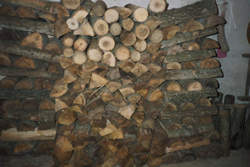seasoned wood

Seasoned wood is wood, used for fuel, that has been air dried so that it has a moisture content of about 20–25% by weight. Because a lot of energy can be wasted burning wet wood, you should always use wood that has been properly seasoned. Such wood is harvested in the spring and allowed to dry throughout the summer. Look for wood that is of even color, without any green. Some well-seasoned wood can actually be too dry for today's airtight modern stoves. If you place wood that is too dry on a bed of coals, it will instantly give up its gases as smoke, wasting unburned smoke and producing creosote buildup.
All species of wood have a similar heat (BTU) content on a per pound basis when completely dry. Therefore, denser woods will generally cost more and burn longer. Woods like oak, hickory, and pine will burn overnight. Aspen builds a hot fire, which helps clean the chimney. See wood heat value (BTU).
When selecting wood, you might also want to find out whether the supplier uses sustainable harvesting practices. Unsustainable practices can negatively impact the environment, causing soil erosion and loss of biodiversity. At least ascertain that the wood was not the result of clear-cutting. Clear-cutting is when all, or nearly all, of the trees are cut down on a piece of land.
Wood only dries from the surface inward, so un-split pieces dry very slowly. To properly season wood, split the logs as soon as possible and stack them in a dry spot for 6–18 months. Pile the wood loosely, allowing air to circulate through the split logs. Hardwoods take longer to dry than softwoods. Humidity and temperature levels also impact drying time.
